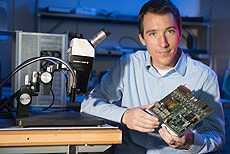Jim Hirschauer receives DOE award to search for supersymmetry
 |
Jim Hirschauer was one of 35 researchers selected for the 2014 DOE Early Career Research Award. Photo: Reidar Hahn |
The search for something new is about the long game. One prepares for every eventuality when seeking out something whose very existence, though possible, is uncertain. One such quarry is supersymmetry, and although scientists can't be sure they'll find it, the excitement of unearthing new phenomena drives them to look.
Fermilab's Jim Hirschauer is one of the scientists on the hunt. Earlier this month, DOE announced that it selected Hirschauer for a $2.5 million Early Career Research Award to look for supersymmetric particles at the Large Hadron Collider's CMS experiment. Hirschauer is one of 35 researchers selected from a pool of about 750 applicants.
"We want to see what's next," said Hirschauer, who is also a 2013 Wilson fellow. "Our current theory works incredibly well for much of what we see, but there are several ways, famously, that it doesn't. We'd like to understand why, and there's reason to think that the solution to these issues might be accessible at the Large Hadron Collider."
Supersymmetry is the theory that the Standard Model, our best picture of how the universe works, is only half the story. Supersymmetry says that every particle in the Standard Model has a corresponding supersymmetric particle yet to be discovered.
The principle is attractive to scientists because it would tie up serious loose ends in our understanding of how the universe hangs together. If supersymmetry bears out, it would explain why the mass of the Higgs boson is as small as it is and how the universe's four forces are really different aspects of a single force. It would also get us closer to a good, working description of dark matter.
The search for supersymmetry at CERN's Large Hadron Collider, which is currently being upgraded to collide protons at almost double its previous energy, has thus far turned up empty. But when the machine turns on again in 2015, scientists will have that much more energy to mine. Its high-energy particle interactions create sprays of particles, among which could be lurking supersymmetric candidates.
If they're out there, researchers hope to be able to call them out, armed with a dossier of possible interaction profiles that could show up in the CMS detector. Some of the profiles would be easier to identify than others.
"We need to be ready in case it's there and obvious," Hirschauer said. "Then we'll be thrilled because we'll have the next decade or so to study it in great detail at the collider."
If supersymmetry is there but obscured, scientists will have to move on to subtler, more painstaking methods to draw it out. There's also the possibility that it shows itself in a way scientists haven't dreamed up.
"Our imaginations are limited, so in addition to targeted searches for supersymmetry, we perform general searches that we think will be sensitive to broad classes of new particles," Hirschauer said.
The particles coming out of a collision decay into other types. Supersymmetric particles produced at the LHC are expected to decay into particles we already know about and other new particles that the detector can't see. Scientists refer to these undetected particles, appropriately, as missing energy.
If collisions produce lots of missing energy, then it's practically a neon sign directing scientists to look there for new physics. But a small amount of missing energy doesn't call attention to itself, and it could mean that supersymmetry may be hiding behind other, obscuring events. Should the initial search for the more conspicuous events with lots of missing energy turn up nothing, Hirschauer's research will change focus to events with low missing energy.
"We start thinking about these more challenging signatures," he said. "If it's not staring us in the face, it could be because either it's not there or it's there but a little harder to tease out from the background. In the second case, we typically need more sophisticated methods and more data, so we need our detector to perform well for a long period of time."
The CMS collaboration is hard at work to ensure the detector will hold up for as long as it takes to corner supersymmetry, if it's there. Hirschauer and his team will help upgrade the electronics and the photodetectors of the part of detector called the hadron calorimeter, which measures the energy of particles made of quarks, including protons, neutrons and pions.
With a robust and sensitive detector and a long-term strategy, there is every chance Hirschauer and his colleagues will hit upon the surprise scientists are looking for. A direct discovery, along with indirect searches such as those conducted in cosmology, will fill in the gaps the Standard Model leaves vacant.
"The multiple-prong strategy, where we have both direct and indirect particle physics searches going on, is important," Hirschauer said. "We hope the full constellation of these experiments will tell us something new."
The DOE Early Career Research Award will support Hirschauer and two postdocs for five years and provide funds for necessary equipment.
Ultimately, though supersymmetry currently garners the most attention, the goal of LHC scientists is to discover the successor of the Standard Model, whatever it may be. "If we discover something new — no matter what it is — everyone will be thrilled," he said. "It's an exciting time to be at the LHC."
—Leah Hesla
|